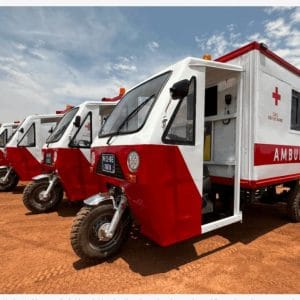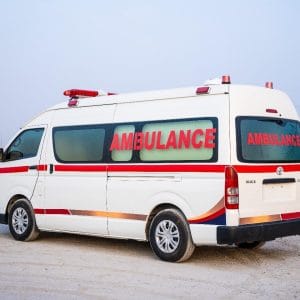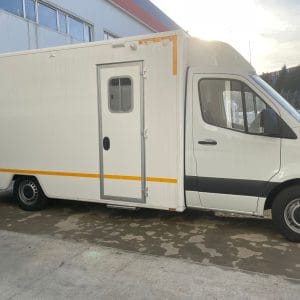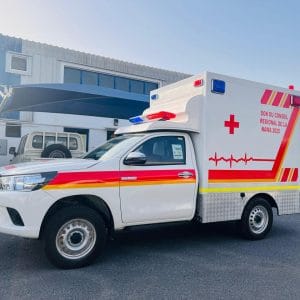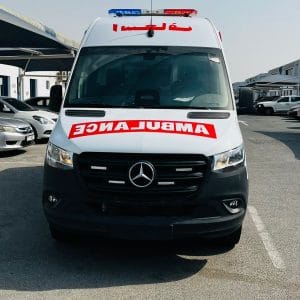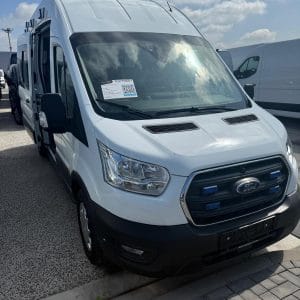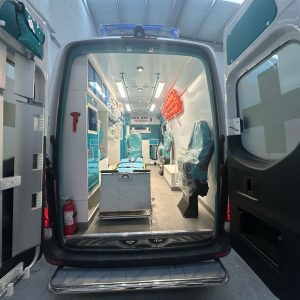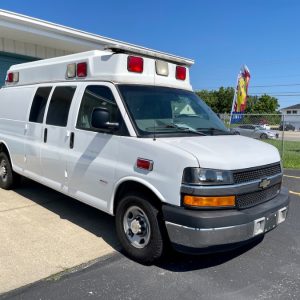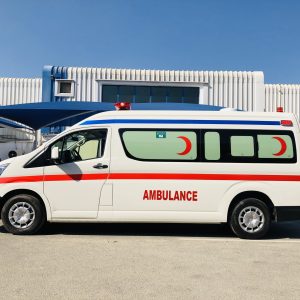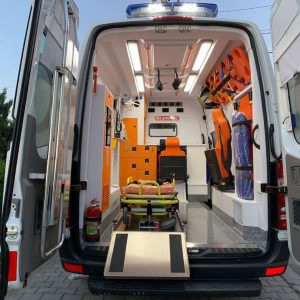1. Introduction to Mercedes Ambulances
Mercedes Ambulance Manufacturer and Medical Equipments; There is no denying the significant role of the ambulance in saving human lives in the event of an emergency. To guarantee these people’s lives and safety, it is necessary to have safe and reliable vehicles and formal institutions, but also to devote themselves to the ambulance production industry. Several technical indicators and medical devices from ambulance suppliers directly affect the offerings for different users. Car safety, comfort, quality, and efficiency features are all reflected in the ambulance. This is unique. As a fast lane, ambulances have been committed to designing, developing, and manufacturing products with excellent quality, reliable performance, and perfect service. They aim to manufacture world-class ambulances. This approach has given the industry a new impetus. The ambulance is too heavy in design and equipment to reflect in a short period of time. It is a special industry. It is a company that imports technology to produce products that meet standards with their own efficiency. As the number of users with ambulances increases, there are some new customers who didn’t know about the brand before. They chose the camouflage ambulance because of its quality. In a sense, this is a technical collection. Unsurprisingly, the ambulance was first confirmed in 1997. It meets important standards for the production process, quality assurance, and vehicle manufacturer’s quality control. Careful observation during ambulance use can serve as a reference for future ambulance design and field operations.
1.1. Overview of Mercedes as a Manufacturer
An Overview of Mercedes-Benz as an Ambulance Manufacturer. When we talk about Mercedes, it is well known worldwide for its engineering excellence. Mercedes focuses on producing high-quality, innovative products that last. Whether it is a luxury car or an ambulance, Mercedes manufacturers grace each and every product with precision. They carry the four-wheeled safety, security, and standards across the range. Our ambulances are larger, stronger, and compact versions of their passenger cars. Mercedes’ stance on safety is if it’s not safe, it’s not a Mercedes. This approach to safety has seen the brand become a trusted partner of various healthcare providers and emergency services across the world. Mercedes conducts extensive and ongoing research and development at our facilities in Germany. Not only are the passenger cars affordable and durable, the same is true for our ambulance units. When you are driving towards an emergency, you need an ambulance you can trust. Mercedes ambulances are built on the first-rate Mercedes SUV chassis with the comfort, suspension, and road handling to match. The body and auxiliary fittings are specially built to provide the safety and durability essential for the needs of the medical profession. Functionality. Ambulance designs and equipment have evolved over the decades as our understanding of medical care has progressed. Emergency vehicles have had to change and adapt to these new practices. Mercedes is the manufacturer of medical equipment vehicles that meet the needs of modern emergency care. Mercedes personally looks at ways to improve our product range and adapt to changes in medical care and technology. Our aim is to ensure that a Mercedes ambulance continues to be a practical and trusted vehicle for the medical profession. Furthermore, by keeping a close relationship with emergency service operators, performers, and clients, Mercedes is always ahead of the curve and current with firefighting and medical equipment trends.
2. Design and Features of Mercedes Ambulances
Design and Features Ergonomics, interior-hatched design for a logical flow of events, clear ways of moving for medical staff and the best possible comfort for patients; these key factors are taken into account when a van is converted into an ambulance. Taking into account experience from over 25,000 ambulances in the intermittent period and the variety of 160 models, we cater for an entirely customized interior. From one supplier, the whole interior is fully customizable with regard to medical equipment, the number of passengers and the possibilities that are available. These further possibilities consist of a wide scale of optional extras in communications, monitored occupancy and status systems such as camera systems, GPS, mobile data terminal systems, lights and sirens, help-call systems, systems, the installation of intercom physician-to-driver systems, which can be activated, or intercom nurse-to-crew compartment and controlled voice and video recording systems. Furthermore, the standard safety features form part of the vehicle and no changes have been made to the exterior due to safety reasons. On one side, ambulances fitted with altered body parts are now involved in both frontal and extremity crash tests and on the other, have a minimum frictional resistance and are designed to be attached to any type of light industrial vehicle. The external component not only gives the vehicle a better aerodynamic performance, but also a much more aesthetic appearance.
2.1. Ambulance Conversion Process
The process of making ambulances starts with designing structures in such a way that it enables their use in a completely isolated manner and specialized for emergency services. Employees come together with communication professionals and physically reveal the inner dimensions vehicles must have. They start the ambulance conversion process by analyzing the feedback from current users. Additionally, for conversion services, the vehicle can also be enhanced with more cooling functions, auxiliary heating, or more spacious dimensions. They continue to work focusing on the details such as transparent roof hatches, door design, interior lighting, and structure. Ambulances that are presented for approval are subjected to several crash tests and finally presented for approval. The converted vehicles were also subjected to extensive testing in accordance with various regulations. All the paintwork on the ambulance is applied in accordance with standards during the final assembly process, and not just before the process begins.
The vehicle interior is fitted with new light tissue technology and the vehicle is given a wide range of personal aids. When designing the ambulance, a lot of importance was attached to the connections between the various elements and the construction. For the conversion debris, state-of-the-art welding robots are used in combination with manual labor and various state-of-the-art systems such as bonding-joining techniques. The power supply for the medical devices in the rear is located under the extended right-hand side and is part of the new energy pack used by commercial vehicles. The high voltage used to drive the electric drive on the front is located under the vehicle body shop elements that were specially developed for the ambulance. This design ensures that the electricity supply for medical devices is protected in the event of an accident. The next step, following the transfer of the vehicle to the emergency market, is the technology for rescue and recovery, from which the emergency response systems will commence. Rescue organizations in various countries buy ambulances through organized bodies.
3. Medical Equipments in Mercedes Ambulances
Inside a Mercedes ambulance, various types of medical equipment are integrated. There is a wide range of medical equipment involved in emergency care inside the vehicle ambulances. The most important zones with medical equipment included in the vehicle layout are the front nearside and offside, rear (both left and right), and the patient compartment. The integration of an externally accessible cupboard for chemical disinfectants stores the necessary chemical equipment in a readily accessible place in the patient’s compartment to prevent the paramedic from limiting the patient’s care and the full cleaning of the ambulance, which externalizes the used medical, sharp, and textile waste and guarantees the security of the paramedic. For smooth care, medical practice in ambulances is as necessary as the state-of-the-art medical equipment and the most usable and easily accessible arrangement of these materials. Furthermore, the good location and ease of utilization decrease the evacuation time of the patient from the vehicle and improve the carer’s convenience during transportation and use on-site with the patient. Over time, the equipment and instruments applied in the healthcare of the ambulance have continued to evolve and expand. Mercedes actively collaborates with global medical equipment suppliers that develop and produce medical devices for the design together with emergency and mobile healthcare experts in providing field-proven solutions. The point of making arrangements with medical equipment manufacturers is to simulate all possible potential internal conditions when using the vehicle, especially when traveling at high speed. Durable and tested cabinet systems are used in the manufacture of the vehicle and during its life. Just as Mercedes-Benz vehicles are developed according to stringent specifications, the testing and stand-alone control of each medical product and equipment are developed in cooperation with established global companies. With their periodic tough tests and controls, Mercedes-Benz ambulances carry hospitals and medical products. All these items and materials on-site are examined for their compatibility and control study within and outside the vehicle. All these devices must be relevant to the specified medical standards by hospitals, emergency services, and global medical interests and authorities at every level, evaluated and used as described in the criteria. The medical equipment carries any amount of medical equipment, to which the properties of this property and the surroundings are available to the user. The technical developments made around the vehicle are closely monitored, and new ones are made every year. It carries state-of-the-art diagnostic and life-support equipment. The latest technical developments and the work carried out in collaboration with suppliers are close to the user. These vehicles come with a technical workshop user’s guideline book.
3.1. Types of Medical Equipments Used in Mercedes Ambulance
Emergency medical services are provided in India in various types of ambulances. Based on the severity or type of the incident, ambulances are categorized as Basic Life Support (BLS) ambulances, Advanced Life Support (ALS) ambulances, Critical Care ambulances, Patient Transport ambulances, and Neonatal ambulances. In general, different types of required equipment are used in ambulances providing necessary services. The common categories of life-saving medical equipment include Life Support Devices, Monitoring Devices, and Diagnosing Devices. The ambulance life support equipment is categorized as equipment required for respiration, ventilation, and circulation. Supporting, recording, and sterilizing devices are also provided along with essential life-saving devices.
Life Support Equipment: – Defibrillators: ECG monitoring units with Automated External Defibrillator functions are provided in ambulances to correct arrhythmias. These devices will be automated and operated using artificial intelligence. – Ventilators: Such devices supplied in mobile ambulances are used to support patient breathing. Such ventilators can be Autofocus ventilators, Auto Settings ventilators, gas delivery devices such as volume, pressure, time, flow, or pressure controlling ventilators, automated running devices, and AI mode devices offering automation from the start of ventilation such as flow, PIP/PEEP, inspiratory to expiratory ratio, tidal volume, maximum vent mode pressure, maximum flow, flow profile, IE, FiO2, passive circuit technology, water collector, and active moisture removal. – Stretcher: The stretcher shall be designed to load up to 3 patients. The stretcher shall be designed with advanced technology for easy and smooth movements inside the vehicle, during loading and unloading, and outside the vehicle with high precision hydraulic power stretchers and powered anti-shock hybrid stretcher systems with antistatic vinyl upholstery offering battery backup with a detailed vehicle loading area concept. The oxymeter shall be integrated/programmed with the ventilator. – Cardiac Pacing Device: Such devices will be supplied in ambulances for fast tracking and restoring of patient regular heart functions which stop due to arrhythmias. New and advanced technology equipment is also provided in the ambulances as required, designed, configured, and supplied to provide the best emergency medical treatments at an affordable cost. It is worthwhile to note that the medical advancements and technology are poised for further improvements in the immediate future for automation, enhanced mobility, online medication and diagnosis, augmented reality, and more care, and we have already designed our ambulance for the integration of future medical care. Ambulance maintenance, workmanship quality, periodic maintenance, facility connections, and staff should have the additional skills to work with the ambulance. Emergency Medical Technicians should have knowledge of maintaining the ambulance at a basic level. The lifecycle of the ERS medical equipment is to be 3 years subject to non-wearing and tearing or expiry of ERS equipment.
4. Safety and Regulations
To guarantee the safety of patients and medical staff inside the ambulance, strict regulations must be followed during the project and manufacturing of a vehicle of this kind. The vehicle is designed to meet the regulations. Although the project targets come from a sequence of laws, a summary of important regulations is given in the next section. A few regulations are ignored for the local project. These laws that are ignored are clearly stated in each of the relevant sections. Keep in mind that most of the regulations state the minimum requirement for the vehicle to be legally used in the majority of cases. The ideal situation is that the ambulance is over-dimensioned and over-budgeted so that a reduction of safety when transporting someone from an emergency would never be necessary.
4.1. Compliance with Medical Standards
Mercedes Ambulance Manufacturer and Medical Equipment
Bürodesign produces vehicles with medical interiors according to the DIN EN 1789 standard. For the additions that can be made due to the fact that the data is general, you should input this standard according to the place of the vehicle. To meet the requirements, the interior design is planned more accurately while the modification is conducted. Thanks to a wide range of accessories, the equipment is easily expanded. The DIN EN 1789 standard divides the vehicle into five classes: type A, type B, type C, type D, and type D-KE according to its features for health services. TopSpeed serves customers by designing and producing all kinds of vehicles using the most advanced technology. The vehicles of the company are deservedly popular since they are produced with luxury and comfort. All ambulance requirements of the customers are fulfilled in the vehicles. In addition, occasionally a special design is required. TopSpeed serves customers by demanding special design, designing, and producing all kinds of emergency vehicles using the most advanced technology. Therefore, the vehicles of the company are deservedly popular since they are produced with luxury and comfort. All requirements for the ambulance are fulfilled in the vehicles.
Mercedes Ambulance Constructions
TopSpeed manufactures Emergency Medical Services vehicles according to DIN EN 1789. The standards provide requirements for the design and performance of medical transportation vehicles and their equipment to allow for safe transportation and basic care of patients. The DIN EN 1789 standard describes the type of vehicles used for transportation, road ambulances, equipment requirements, vehicle layout, operating conditions, as well as driver and attendant accommodations. According to bodywork design, TopSpeed is the largest ambulance bodywork manufacturer in Turkey. The DIN EN 1789 standard is being followed, and the vehicles have valid certifications. TopSpeed Bodywork is built in Turkey, at the Istanbul and Ankara plants. With over 20 years of experience, TopSpeed is the only and the biggest manufacturer of Emergency Medical Services vehicles in Turkey. Customers are also ordered according to their needs and authorities’ proposals; ambulance vehicles are serving 24/7 everywhere throughout Turkey. An important document to standardize the ambulance vehicles’ year-round conformity, and the vehicle standards are required. Final users or emergency authorities need to prefer exact standards. Preliminary identification explains that the regulation defines the function, device constraint definition, requirements and parameters, test procedures, conformities, and production information. Since there must be conformity, transmission is usually published throughout the country, and the standards must be written by professional groups or experienced industry authorities. Whether a national standard or adapted to certain conditions, flexibility may be given according to local regulations. Consequently, the DIN EN 1789 ambulance services, bodywork, and economic growth, TopSpeed DIN EN 1789 emergency medical service vehicles are designed and produced depending on terms of quality; this service is delivered to the patient during transportation safely and without unnecessary delay; an inexpensive medical intervention resolved in a given location that patients with a range of more tactics or medical treatment will not only be admitted to wherever.
5. Future Trends in Ambulance Manufacturing
The Mercedes-Benz cars have long been popular in the luxury car segment. Of late, Mercedes has made an ambitious thrust into the segment of sports utility vehicles (SUVs) with the launch of GLC and GLE. Its control center for ambulance cars, which covers all of its range of cars, listened to the speakers and led the discussions. The discussions covered topics related to the future trends in the sector of ambulance cars, as well as the medical emergency vehicles. An interview concerning the manufacturing of the ambulance cars by a leading luxury car maker is as follows:
The new technologies and innovations that are coming by leaps and bounds have a direct impact on the design and manufacture of ambulances. In certain advanced markets, advanced technologies that have undergone developmental phases are being inducted in the design of the cars. There is an increasing impetus on vehicular pollution checks and emission regulations, which have led to greater attention towards sustainability. Thus, ambulance vehicles are designed and manufactured in such a manner that they cause zero or minimum pollution. We are talking of electric cars and light EVs. The conventional diesel engine vehicle could also possess mild-hybrid technology. Connected vehicle technology and telemedicine are the future of ambulances. We are planning to inculcate these in our design. Regulatory standards, sometimes, are the major driving force behind the design of ambulances. In anticipation of coming changes, a different set of assumptions is taken into consideration during the time of designing and manufacturing the vehicles. Advances in analytics and big data are directed towards making the emergency services more effective. Customized ambulances are available as per the prevailing need, from basic to complex ones, the design of which will undergo changes as per the change in requirement. The focus on mobile emergency care is not only on the manufacturing of the vehicles but is also on the manufacturing of medical equipment such as defibrillators.



